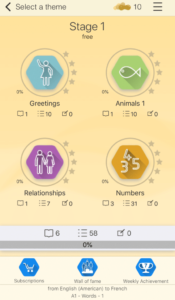
Currently boasting over 800,000 users, Qlango seems to be rising in popularity within the realm of language learning apps.
I tried out the app for a few days, primarily focusing on French lessons but investigating some of the other languages lessons, as well.
In this review, I take a close look at Qlango: what it offers, what it’s missing and what it can best be used for.
What Is Qlango?
The quick answer: Qlango seems best suited for beginners starting from zero, and offers a lot fun, goal-oriented language exposure. Once you graduate from the A1 level, you won’t be able to use Qlango anymore. It doesn’t offer anything (yet) for intermediate and advanced learners, and it isn’t ideal for learners who prefer more holistic lessons or deep grammar explanations.
Features
Available for both iOS and Android devices, Qlango offers lessons for a total of 43 languages. English learners can access 40 of those languages.
The app also gives you the ability to learn with language pairs. That means that, if it’s available, you can learn a new language in your own native language. For example, if you’re most comfortable with the French language, you can learn German in French!
You’ll learn a number of essential vocabulary (separated into “stages”) in your targeted language. These will be taught in the form of brief text-and-audio questions and answers, with pronunciation for the words available at a single tap.
As designed, Qlango doesn’t give you much instruction in the language, so you’ll be learning plenty of things on the fly. There also isn’t much of a tutorial, since everything is very straightforward both in visuals and text.
Qlango expects you to study on a schedule (which is based on your choice of how many lessons you’d like to learn in a week). You can view your weekly achievements to see how well you’ve followed your goals, and you’ll also be told if you’re falling behind in your lessons.
You also get rewards in the form of “peanuts” that you can use for various things like unlocking “locked” lessons early. You get peanuts every 24 hours, so you can consider them as counters that mark your daily usage of the app.
To be honest, in my experience with the free trial, peanuts don’t serve much of a purpose, and I couldn’t find any information that suggests that they do much more. So while it’s a cute idea, Qlango could definitely do more with it in the future.

Qlango also features a leaderboard called the “Wall of Fame” that shows how you fare against other users learning the same language. The more games you play per day, the higher your position will be.
I didn’t really pay attention to this, but if you’re the competitive type, then this feature can certainly be a nice motivational factor!
How It Works
Once you choose your target language (and the native language you pair it with), you then choose your learner level.
This didn’t take me long, as I had only two options to choose from based on the Common European Framework of Reference: A1 (beginner level, with an emphasis on very simple communication) and A2 (elementary level, with a stronger emphasis on getting information across accurately).




